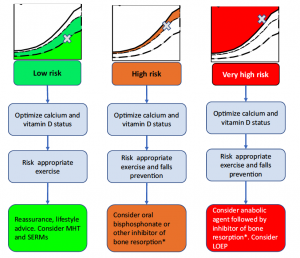Imminent risk of fracture and early use of anabolic agents are key features of a new algorithm to guide osteoporosis prevention decisions for postmenopausal women.
Australian researchers helped develop the new algorithm, which has been designed to ease the implementation of guidelines published by the International Osteoporosis Foundation in 2019.
They say the algorithm is designed to incorporate latest thinking on fracture prevention, based on low, medium and high categorisation of fracture risk.
 Published in Osteoporosis International, the algorithm encourages very early intervention after a sentinel fragility fracture, based on recent evidence that the risk of a subsequent osteoporotic fracture is particularly acute in the immediate period afterwards.
Published in Osteoporosis International, the algorithm encourages very early intervention after a sentinel fragility fracture, based on recent evidence that the risk of a subsequent osteoporotic fracture is particularly acute in the immediate period afterwards.
By the same rationale, the algorithm encourages treatment with agents that have the most rapid effect on fracture reduction, namely anabolic agents in people with the highest fracture risk categorisation.
The algorithm offers three treatment pathways based on categorisation of patients with a 10-year probability of a major osteoporotic fracture.
Examples of patients in the very high risk category – who would be targeted for treatment with an inhibitor of bone resorption – include those with a prior fragility fracture of undetermined recency in addition to a family history of hip fracture.
Sequential treatment with anabolic therapy followed by antiresorptive medications for a total of 10 years might be expected to save 33.8 hip fractures/1000 patient years in women age 70 years with a recent fragility fracture, the algorithm authors note.
The lead author of the algorithm is Professor John Kanis, professorial fellow at Mary McKillop Health Institute, Australian Catholic University, Melbourne.